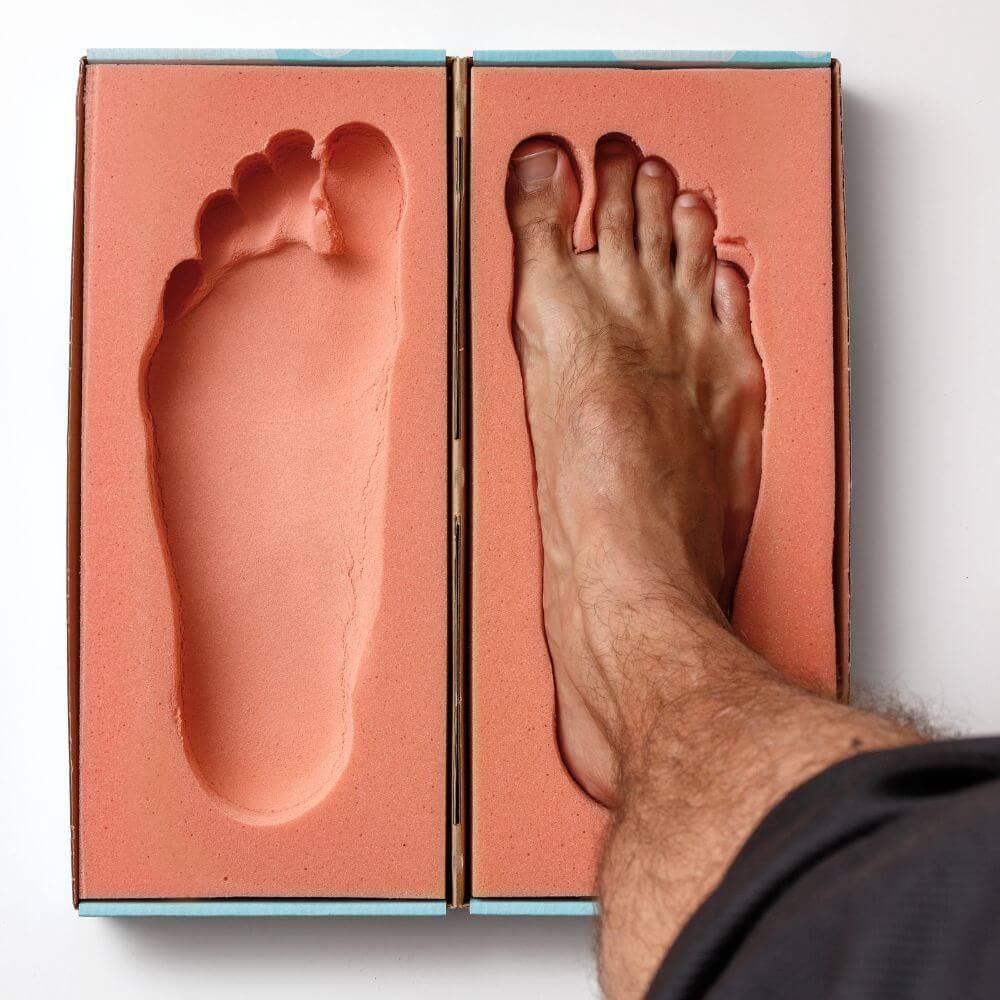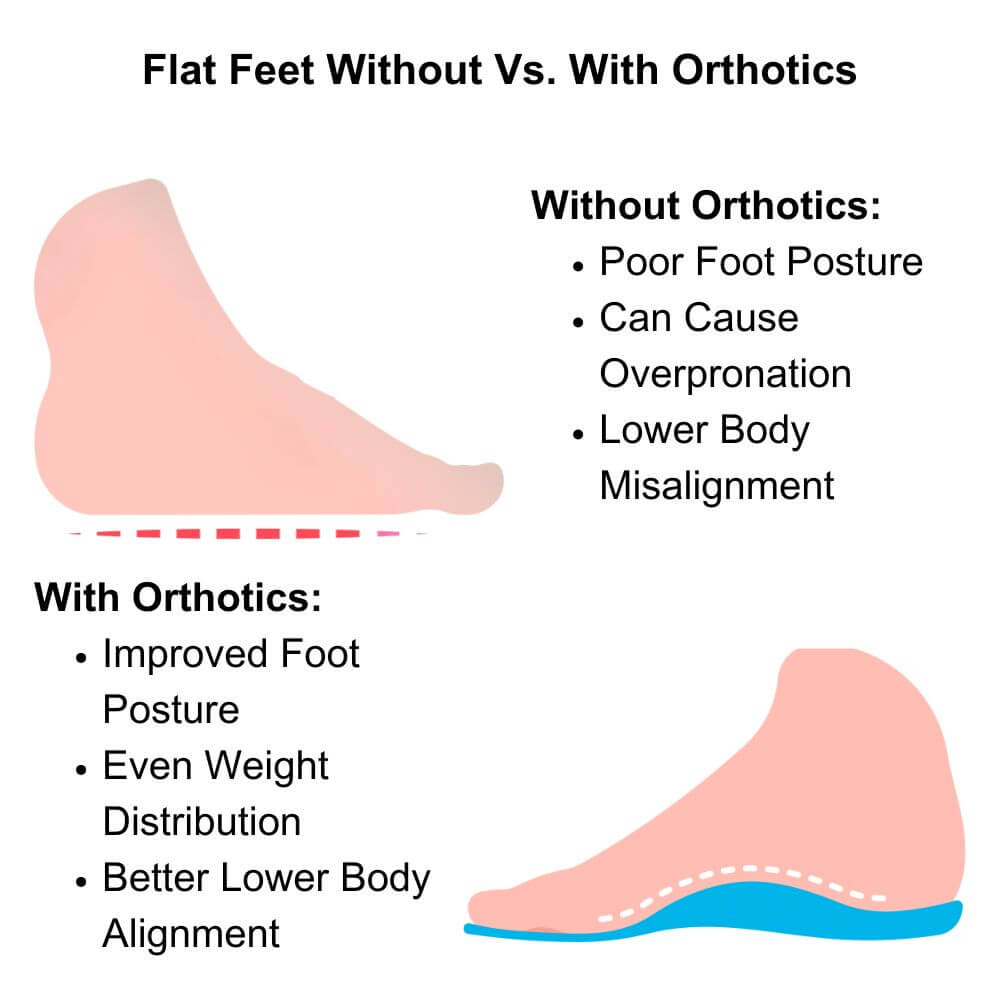free shipping desktop
When Is a Custom Orthotic Necessary?

Orthotics are widely known and, for many of us, probably bring to mind the Dr. Scholl’s inserts you’ve undoubtedly stumbled upon at Walgreens, CVS, Walmart, Target, shoe stores, and many other retailers. While the over-the-counter variety is recognized and has been worn by millions of people over the years for both corrective and preventative reasons, they make up a small slice of the overall orthotics pie.
We’ll discuss what orthotics are, some common types, and when it may be necessary to move to a custom orthotic for your foot condition.
What is an orthotic and what are the different types?
An orthotic is a device inserted into a shoe, typically to stabilize the foot, correct alignment, alter weight distribution, and/or provide targeted cushioning. Orthotics can be either custom-made based on an individual’s specific anatomical and physiological needs, or they can prefabricated to address common conditions experienced by many individuals.
The orthotics we know today are a tremendous progression from their roots, which are thought to go back as far as 2,000 years when layers of wool were inserted into sandals to relieve foot strain and fatigue. Over the years, orthotics have become far more specific, with many categories and subcategories of orthotics existing with modern technology and research.
Today, the two primary types of orthotics are functional and accommodative. Functional orthotics are primarily used to control abnormal or inefficient foot and ankle movement to normalize alignment and gait mechanics. Accommodative (soft) orthotics are used primarily to provide added cushioning and support, and to redistribute pressure for medical conditions that may predispose a person to pressure or friction injuries or pain (such as diabetic foot ulcers), or to reduce pressure on painful areas of the foot that were acquired through overuse, poor footwear, repetitive daily activities, athletics, or other causes.
Within these categories, many subcategories exist, which we will not go into detail about in this article. Some of these include gait plates, heel lifts, pediatric orthotics, and sports orthotics.
To further subcategorize these, both functional and accommodative orthotics can be either prefabricated (over-the-counter) or custom-made.
Prefabricated Orthotics (Over-the-Counter)
Prefabricated orthotics are what many of us think of initially when we think of orthotic shoe inserts. They are mass-produced by companies such as Dr. Scholl’s, Superfeet, Vionic, and many others. For this reason, they are often quite affordable and immediately available. Think about prefabricated orthotics as being made for general, common foot conditions that can be beneficial to individuals with low-severity conditions and deficits. They’re often a great place to start for people that need just a little adjustment in either their foot/ankle alignment, padding, or weight distribution. They may also be of great benefit for those that need a short-term solution to an acute injury.
Custom Orthotics
Custom orthotics, on the other hand, are designed specifically for one individual. Since this requires the evaluation of a medical professional (most often a podiatrist) and is designed as a one-of-a-kind solution for a person’s specific needs, the cost is typically much higher, though part or all of this cost may be covered by insurance, depending on the plan.
This individualized approach often comes with the advantage of precise corrections and tailoring as needed, but this may result in additional costs. Custom orthotics are often most appropriate for chronic or higher severity conditions that prefabricated options cannot adequately address.
They are generally made by using a mold (foam box impression or plaster casting) or digital scanning (3D scanners) of your foot to capture the unique contours, alignment, and biomechanics of your feet to design orthotics that address specific needs. This allows for a device to be created that is tailored to your foot shape for custom support.

Heat-Moldable Orthotic
There is a bit of a gray area for an orthotic classification that sits right in the middle. This type of orthotic is known as a heat-moldable orthotic. Heat-moldable orthotics are definitionally classified as prefabricated orthotics, but they offer a degree of individualized customization.
As the name implies, they can be shaped and re-shaped with the use of heat. While the materials are hot, they allow for custom adjustments to meet a person’s individual needs. When the materials cool, they harden and hold the shape that was established while the orthotic was heated.
While not as elaborate as custom orthotics, they provide a level or personalization at the price point of a traditional prefabricated orthotic, making them a great option for people with low severity conditions who may require some specific alterations to what the traditional over-the-counter options can provide.
Comparison of Orthotic Types
| Type | Best For: | Cost | Pros | Cons |
| Prefabricated Orthotics | Mild issues, general comfort | Low to Moderate | Affordable, readily available | Limited personalization |
| Heat-Moldable Orthotics | Mild-to-moderate conditions | Moderate | Semi-customizable, cost-effective | Less durable than custom options |
| Custom Orthotics | Severe, chronic, or complex conditions | High (insurance may help) | Tailored for specific needs, long-lasting | Higher upfront cost |
Which conditions may necessitate the need for an orthotic?
When it comes to prefabricated orthotics, individuals with mild forms of plantar fasciitis, pes planus (flat feet), metatarsalgia, painful blisters/calluses, overpronation or pes cavus, and other general foot pain are most likely to benefit. Additionally, prefabricated orthotics may be worn as a preventative measure or simply for comfort for individuals who do not have a known condition or anatomical abnormality. In some cases, a prefabricated orthotic is not used in response to medical necessity, but rather for prevention, comfort, general alignment, and/or temporary pain relief.
Custom-made orthotics are much more driven by medical necessity and typically are necessary for people with moderate to severe foot or ankle conditions. Commonly, people with more severe cases of the conditions outlined in the paragraph above may benefit from custom orthotics. In addition, people with systemic or degenerative conditions may require this option. Some conditions in this category could include diabetes (which can result in an array of foot-related issues), osteo- and rheumatoid arthritis, bunions, hammertoes, chronic foot, ankle, knee, hip, or back pain, and, importantly, anyone who has not experienced the necessary relief or results after attempting over-the-counter options for their orthotics.

How do I know which type of orthotic is best for me?
Determining if an orthotic is right for you and, if so, which type will be most effective, comes down to several considerations. First, it’s important to assess your condition on a personal level. Do you have a diagnosed medical condition affecting your foot or ankle anatomy or physiology? Are you experiencing pain? Have you noticed any functional deficits due to your feet or ankles? If so, what are those deficits and how limiting are they?
Next, it’s important to determine your entry point into the orthotics world. Consider whether orthotics are a realistic solution to the problem you wish to solve, or whether you would be better served starting somewhere else. This may mean using footwear for wider toe box or improved arch support and cushioning, adapting daily activities in some way, or focusing on improving your physical health through improved nutrition and exercise. If you’re not sure, it’s always best to speak to a healthcare provider such as your primary care provider, who may refer you to a podiatrist, orthopedic physician, physical therapist, or other specialist depending on what symptoms or deficits you present with.
When it is determined (either by you or in conversation with your healthcare provider) that orthotics may be warranted for your condition, limitations, and goals, you need to evaluate whether starting with a prefabricated orthotic is worth the time or if you need to consult with a specialist regarding a custom orthotic. The best way to determine if a custom orthotic is the right path for you is a detailed conversation with your healthcare provider about the severity and limitations of your condition and what you have and have not already tried in your mitigation efforts.
Suggested Orthotic Type Based on Condition
|
Prefabricated Orthotics:
|
Custom Orthotics:
|
Custom orthotics may be used as the primary intervention in treating your condition, but more commonly, they are just one piece of the larger puzzle. If you have chronic and moderate-to-severe symptoms or deficits affecting your feet, ankles, or gait mechanics and your healthcare provider believes you will benefit from custom orthotics, they can present an excellent and versatile tool that can create both immediate and long-term improvements. For those with mild conditions or seeking prevention measures, as outlined previously, over-the-counter orthotics often provide wonderful outcomes at an affordable price. Regardless of which option is right for you, when paired with other treatments to address underlying issues, the results can greatly enhance movement, function, and life satisfaction.
About author:
Troy Hurst, PT, DPT, is a licensed physical therapist who received his Doctor of Physical Therapy degree from Carroll University in 2017. He specializes in the treatment of orthopedic and vestibular conditions, and has been a freelance medical writer since 2018.

